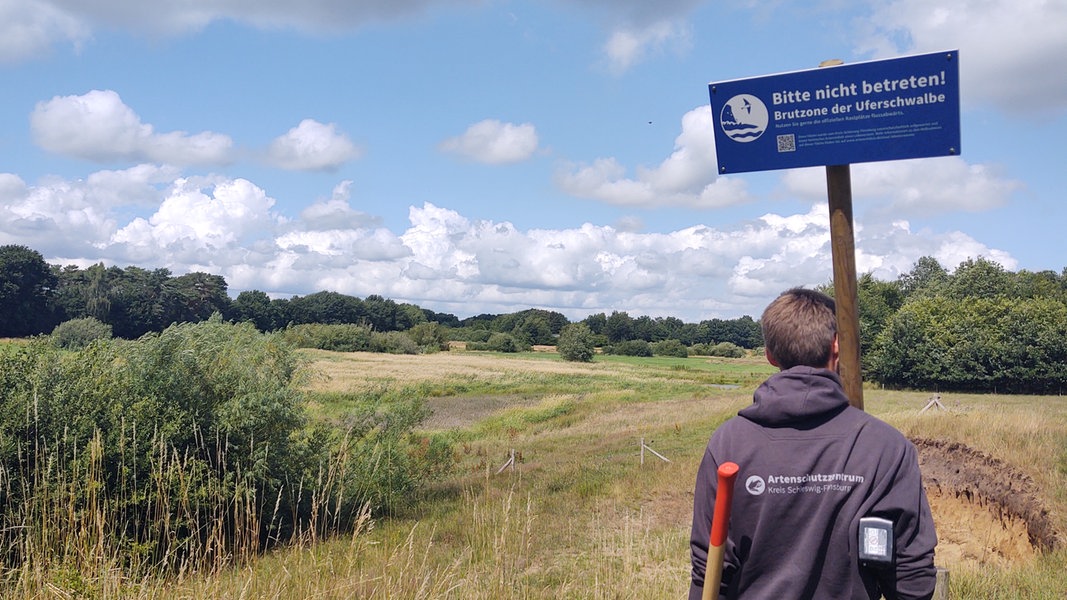Status: 07/13/2023 5:29 p.m
The district of Schleswig-Flensburg is a pioneer in protection against the consequences of climate change. In a survey by NDR, BR, WDR and Correctiv, he did particularly well. Flooding threatens not only on the Baltic Sea, but also inland.
Near Langstedt (Schleswig-Flensburg district), the Treene is still a small river, just wide enough for canoeists. Only ten meters above sea level, but still more than 60 river kilometers away from the North Sea, it meanders through an idyllic valley. Reed grows up. A band of lush greenery and individual ponds runs through the valley despite the drought in June.
Only moist soil is suitable as a water reservoir
But things looked different here up until five years ago, says Thorsten Roos, head of the Environment Department in the Schleswig-Flensburg district. Underground pipes removed moisture from the grassland – with fatal consequences: “You know that at home: If you haven’t watered your flower pots for a long time, the peat will dry up. And then it will lose its storage capacity forever. That’s why peat must always be kept moist.”
Flood protection and protection of species in combination
The pipes have now been removed and drainage ditches filled. Now the moor is supposed to build up again so that the soil can absorb more water when it rains. The summer months are crucial. The substrate gains the properties of a sponge. It may sound paradoxical, but wet soils can absorb more water than dry ones. Roos emphasizes: “Damp is not wet.” A positive side effect: the biotope offers a habitat for many rare species.
Further information
Drought, heat, more frequent extreme weather: the first municipalities in SH are rescheduling, but by no means all: an overview for Schleswig-Holstein. more
Schleswig-Holstein’s west coast becomes a bathtub
Flood protection is an issue on the Treene. Strong westerly winds lasting several days in autumn or winter mean that the Eider barrier remains closed even at low tide due to the high level of the North Sea. The water from Eider and Treene then backs up. If it then rains continuously, the water stands up to the edge of the small river dyke. Villages like Hollingstedt have threatened to flood several times in recent years. It was close.
“We need a lot of Langstedts”
Roos is convinced: it doesn’t take one expensive, high dyke, but many smaller projects to regulate flood events in a natural way. The flood in Gelting in 2011 would also have caused less damage if more renatured areas in the vicinity had absorbed the water, says the head of the department. A polder has since been built there. Five kilometers downstream from Treene, the Jübek – the name of the village – flows into the Treene. Here the old, winding river course was restored to reduce the flow speed.
Farmers register themselves
However, the challenge is less to implement such projects. It is much more difficult to get the required areas. “We don’t clean doorknobs,” Roos points out. Instead, he is counting on word of the district authority’s interest in areas for which he is willing to pay a reasonable price getting around among the farmers. It’s a fight against windmills, says Roos: “We’re working against the unbroken trend that more and more areas are being drained.” After all: With four full-time positions for adaptation to climate change, the district of Schleswig-Flensburg is particularly well positioned in a nationwide comparison.
Coastal protection in the hinterland on the Baltic Sea
The pilot island protects the 40-kilometre loop from Maasholm via Kappeln to Schleswig from extreme floods.
The rising sea level has direct effects on the coasts. The district of Schleswig-Flensburg has more than 100 kilometers of shoreline along the Flensburg Fjord, the open Baltic Sea and the Schlei. There are also some steep coasts. A dyke at the forefront would be an extreme intrusion. Here Roos promotes the combination of the natural undulations in the hinterland in combination with structures for coastal protection, even if agricultural areas could be submerged at times. He wants to talk to the water and soil associations. Landowners could get other land in exchange. But these ideas are just the beginning.
Can slime mouth be kept?
A special case, however, is the protected bird sanctuary Oehe-Schleimünde with the pilot island. It protects the 40-kilometer Schlei from Maasholm via Kappeln to Schleswig from extreme floods, but has been flooded again and again in recent years. So far, EU rules have prohibited intervention, Roos clarifies. He considers the idea of building a kind of barrier to be unrealistic. In a few years, however, there may be a struggle to stabilize the current situation.
Further information
Heat, drought, heavy rain: Which regions in the north are badly affected by climate change? And what climate adaptations are they making? more
In 2011, the entire village center was flooded as a result of heavy rain. After a long struggle, the building is finally finished. more
Schleswig Holstein Magazine
This topic in the program:
Schleswig-Holstein Magazine | 07/13/2023 | 14:00 clock
